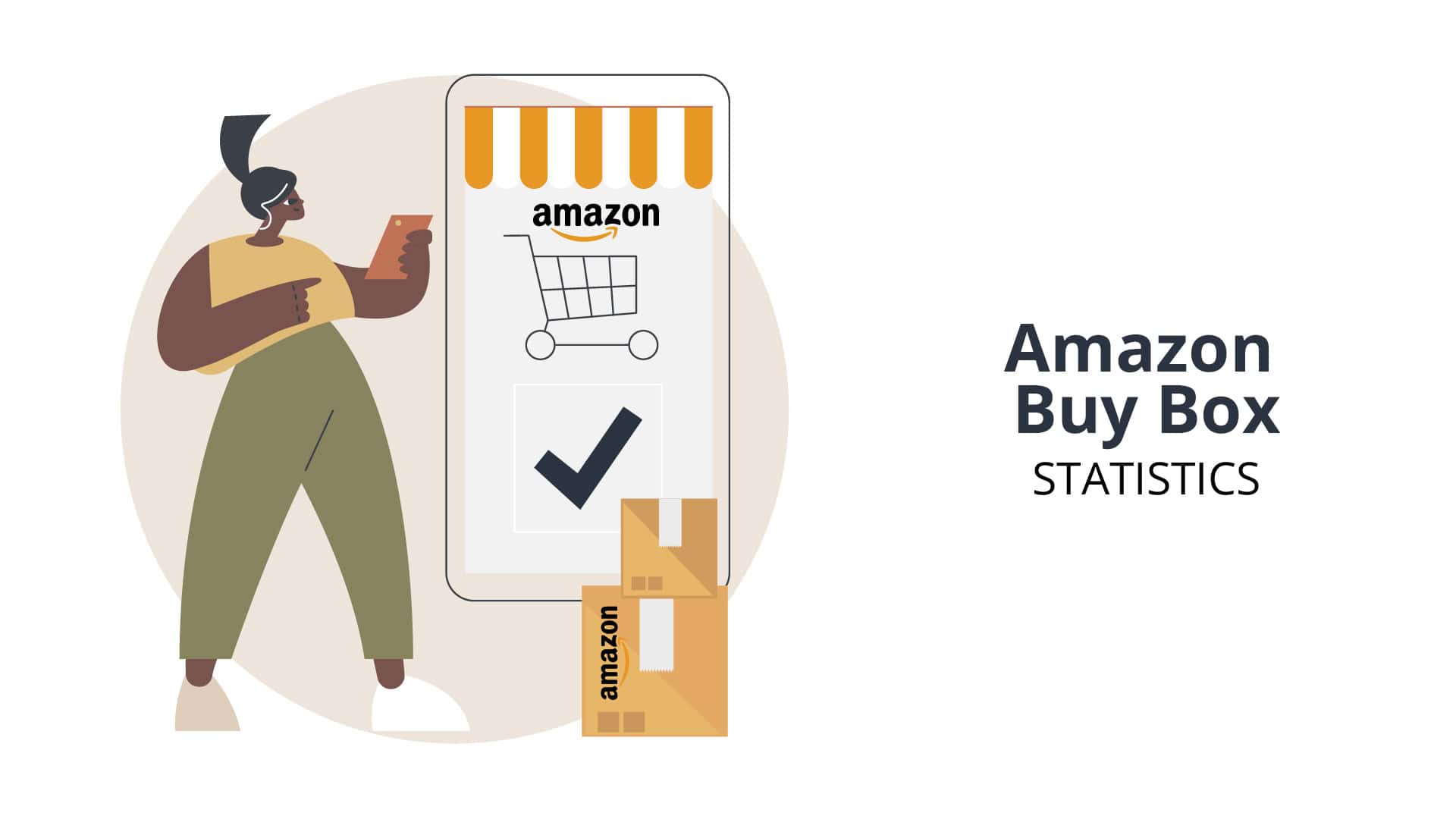Nike Statistics By Revenue, Share and Facts

Updated · Feb 11, 2025


TABLE OF CONTENTS
- Introduction
- Editor’s Choice
- Facts About Nike
- Nike Revenue Statistics
- Nike Shoe Revenue
- Nike Shoe Revenue By Region
- Nike Shoe Market Share by Gender
- Nike Shoe Sustainability
- Nike Employee Statistics
- Nike Demographics
- Nike Geographical Statistics
- Nike Advertising Statistics
- Nike Stores Worldwide
- Nike Sponsorships and Endorsements
- Most Expensive Nike Footwear
- Nike Endorsements Facts
- The Popularity of Nike
- Technology Used by Nike
- Conclusion
Introduction
Nike Statistics: Nike is a multinational corporation engaged in manufacturing, designing, and globally marketing equipment, footwear, clothing, and services. It is the largest provider of athletic footwear and clothing and a major producer of sports equipment. The company’s headquarters are located near Beaverton, Oregon, in the Portland metropolitan area.
Nike was founded by Bill Bowerman and Phil Knight as “Blue Ribbon Sports” on January 25, 1964, and was officially renamed “Nike Inc.” on May 30, 1971. Nike also produces sportswear and equipment and operates retail stores under the name Nike Town.
The company has long-standing relationships with famous athletes and teams worldwide and is known for its slogans “Just Do It” and the Swoosh Logo. More details about Nike’s statistics will be provided in the following article.
Editor’s Choice
- In the fiscal year ending May 31, 2024, Nike’s global revenue was approximately USD 51.36 billion, showing only a slight increase from the previous year.
- As of 2021, the United States was Nike’s largest market, generating nearly USD 17.2 billion in revenue.
- In 2022, Nike spent USD 3.1 billion on marketing and promotion activities.
- Nike is ranked among the top 50 most valuable companies globally, with a market capitalization of USD 197.8 billion.
- Nike and its swoosh logo are registered trademarks in 170 countries around the world.
- As of 2022, Nike operated 1,046 retail stores worldwide.
- According to Forbes, Nike is the world’s 13th most valuable brand, surpassing Adidas, which ranks 51st.
- In February 2022, Nike.com received nearly 98 million visits, with 34% of these visits from the United States, followed by 11% from the Republic of Korea and 8% from the UK.
- In 2021, Nike held about 27% of the U.S. sports footwear market.
- In the second quarter of the 2022 fiscal year, sales for NIKE Direct grew by 16% to USD 5.4 billion, with digital sales increasing by 25%.
- Nike’s assets include buildings valued at USD 2.44 billion and machinery and equipment worth USD 2.75 billion.
- As of February 2023, Nike’s market capitalization was USD 197.43 billion.
- Nike ranked 85th on the Fortune 500 list, making it the 85th largest company in the U.S. based on revenue.
You May Also Like To Read
- Ralph Lauren Statistics
- The North Face Statistics
- Nikon Statistics
- Canon Statistics
- Adidas Statistics
Facts About Nike
- Nike is one of the most well-known brands globally, recognized by its iconic ‘Swoosh’ logo and “Just Do It” slogan.
- Nike is the largest supplier and manufacturer of athletic shoes and apparel in the world. It is also a major producer of sports equipment.
- The company owns several brands, including Nike, Converse, and Jordan.
- Nike is headquartered in Beaverton, Oregon, USA.
- Other major competitors in the industry include Adidas, Puma, and Under Armour.
- Nike is named after the Greek goddess of victory.
- The company markets various products under its brand, such as Nike Pro, Nike+, Nike Blazers, Nike Dunk, Air Max, Air Jordan, and Phantom.
- Nike sponsors many famous athletes, including Cristiano Ronaldo, Rory McIlroy, LeBron James, and Rafael Nadal. The company also sponsors sports clubs like FC Barcelona and Paris Saint-Germain.
- Nike is the most valuable apparel brand worldwide, with a brand value exceeding 30 billion U.S. dollars.
- In addition to leading the sports clothing market, Nike is the most valuable apparel brand overall.
- The company has a strong financial performance, generating over 50 billion U.S. dollars in revenue in the last two financial years.
- Nike’s sales come from three main segments: footwear, apparel, and equipment. Footwear is the largest segment, bringing in about 33 billion U.S. dollars in the fiscal year ending in May 2024.
- Although Nike’s revenue in 2024 was significant, the company’s sales growth was less than one percent compared to the previous year.
- Nike’s North American sales slightly declined compared to 2023.
- The direct-to-consumer segment, “NIKE Direct,” did not perform as well as expected in 2024.
- In 2023, Nike is expected to produce over 800 million pairs of shoes, which is a 2.6% increase from the 780 million pairs produced in 2022.
- An expert estimates that Nike sells around 26 pairs of shoes every second.
- The average weight of a pair of Nike shoes is about 880 grams, with each shoe weighing 440 grams.
- A Nike shoe generally lasts between 1 to 3 years, or approximately 200 to 300 miles of usage.
- Vietnam remains the top source for Nike footwear in 2023, contributing 50% of the total production.
- Indonesia follows with 27% of Nike’s shoe production, while China accounts for 18%.
- Before the pandemic in 2019, China was the second-largest producer of Nike shoes, with 23%, just ahead of Indonesia at 21%.
- In 2020, Indonesia overtook China as the second main source of Nike shoes, producing 24% compared to China’s 22%.
- Nike has steadily reduced the number of shoes made in China. From 2018 to 2023, the production of Nike shoes in China decreased by 30.8%.
- In contrast, the production of Nike shoes in Indonesia increased significantly by 42.9% over the same period.
Nike Revenue Statistics
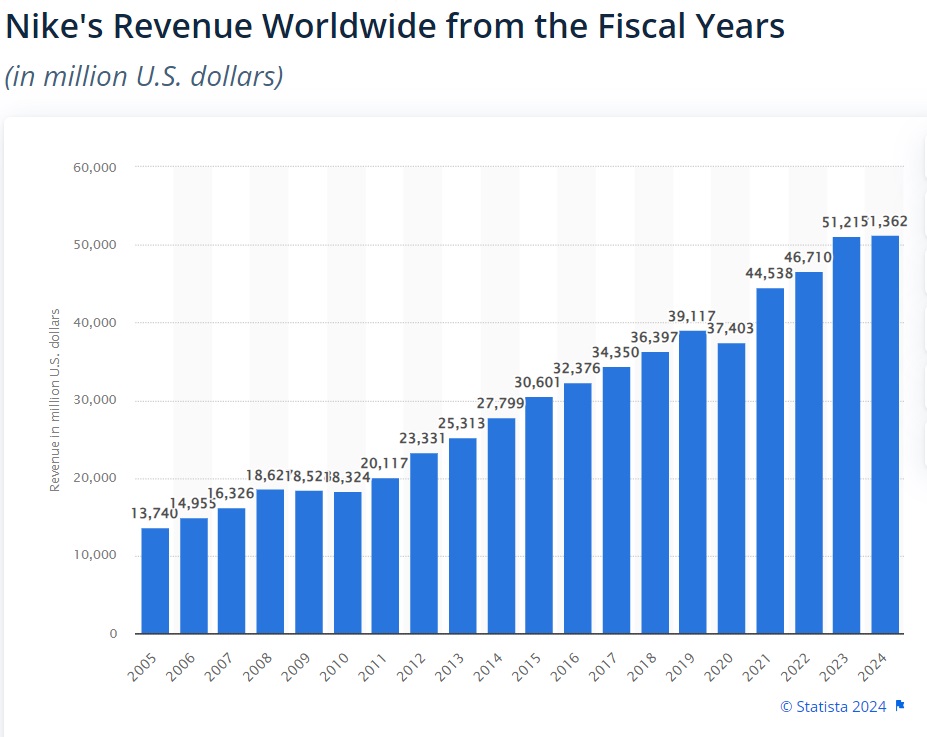
- Nike’s global revenue for the fiscal year ending on May 31, 2024, was approximately USD 51.36 billion.
- This revenue showed only a slight increase compared to the previous year.
- In contrast, between fiscal years 2022 and 2023, Nike’s revenue grew by about 10%.
- Nike, founded in January 1964, is the world’s top supplier of athletic shoes and apparel.
- The company is also a major manufacturer of sports equipment.
- As of 2024, Nike employed over 79,000 people worldwide.
- Nike sponsors many famous athletes, including Cristiano Ronaldo, Rafael Nadal, Lebron James, Naomi Osaka, and Rory Mcllroy.
- These athletes use Nike products and help promote the company’s technology and design.
- Nike also provides uniforms for various sports teams, such as Barcelona and Chelsea.
- Although Nike is an American company, its products are popular worldwide.
- A survey by Statista in Europe found that around 94% of online sports and outdoor goods shoppers in the UK and Germany recognized the Nike brand.
- Additionally, over 60% of respondents in the UK and Germany said they liked the Nike brand.
Nike Shoe Revenue
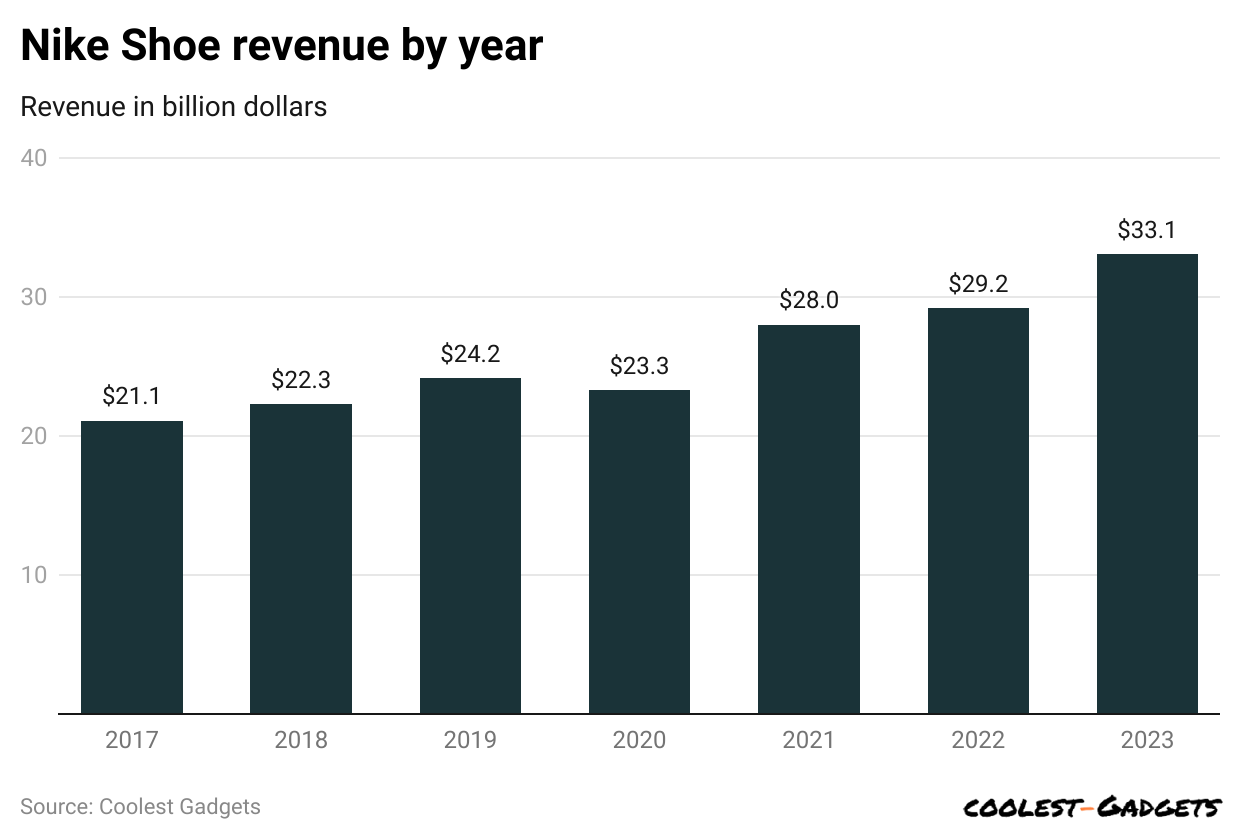
(Reference: runrepeat.com)
- Nike’s revenue dropped 3.75% during the pandemic in 2021.
- Roughly, the total sales of Nike footwear did not decrease. This deduction in the rate is caused by the increase in sales of Nike apparel, which took up 29% in 2021 and 29.9% in 2022.
- About 1.3 points increase from the previous 66.8%.
- Compared to 2020, the highest rate of increase in total revenue for past years was when the figures rose by 20.2%.
- In 2018, the total revenue was $22.3 billion, with 5.7% growth, whereas in 2019, it was $24.2 billion, with 8.5% growth.
- Nike’s total shoe revenue share reached $29.2 billion in 2022.
- In the years 2022 and 2023, Nike’s total revenue was $29.2 billion and $33.1, with 4.3% and 13.4%, respectively.
- In 2023, Nike’s footwear sector registered a 68% share compared to the total company revenue.
- During the COVID-19 pandemic, Nike’s footwear revenue share increased from 66.2% to 66.7% and grew to 67.4%.
- From 2017-2022, the Nike shoe market comprised 64.5% of Nike’s total company revenue.
- As compared to the value of 2017, Nike’s shoe revenue has increased by 38.4% in 2023.
- In 2020 and 2021, Nike’s total revenue was $23.3 billion and $28.0$28.0, respectively, with growth rates of 8.5% and -3.7%, respectively.
|
Year |
Market share |
| 2011 |
17.9% |
|
2017 |
18.9% |
| 2020 |
27.4% |
|
2023 |
30% |
- Nike held 38.2% of the total footwear market in 2022.
- In the athletic footwear market, Nike’s share is expected to reach 30% in 2023.
- This marks a 2.6% increase from its 27.4% market share in 2020.
- Since 2011, Nike’s presence in the athletic footwear market has grown by 67.6%.
- Nike’s market share in athletic footwear was 17.9% in 2011.
- By 2017, Nike’s market share in athletic footwear increased slightly to 18.9%.
- In 2020, Nike’s market share in athletic footwear rose to 27.4%.
- Nike’s growth in the athletic footwear market reflects its strong position and increasing influence over the years.
Nike Shoe Revenue By Region
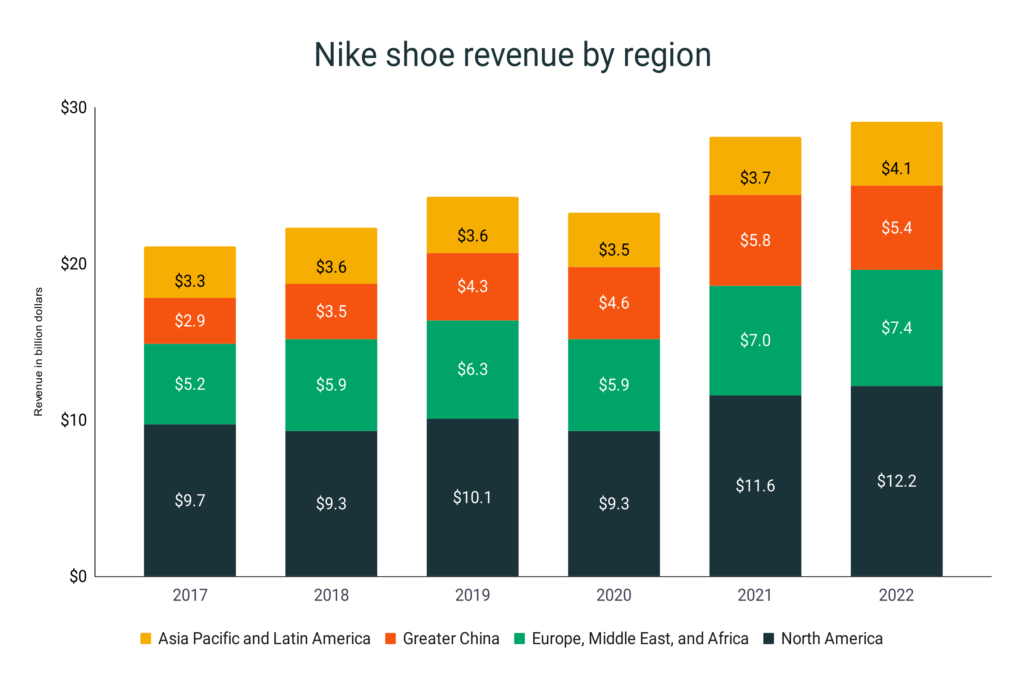
- In 2022, North America was Nike’s largest market, generating $12.2 billion in total sales.
- North American revenue grew by 5.2% compared to 2021.
- From 2017 to 2022, Nike’s footwear revenue in North America increased by 25.8%.
- During the pandemic in 2020, all regions saw a decline in revenue, with North America being the most affected, experiencing a 7.9% drop.
- In contrast, China saw a 7% increase in sales during the same period in 2020.
- The combined revenue from Europe, the Middle East, and Africa was Nike’s second-largest market segment in 2022, with $7.4 billion in sales.
- Greater China was Nike’s third-largest market in 2022, contributing $5.4 billion in revenue.
- However, this was a 6.9% decrease from its $5.8 billion sales in 2021.
- Despite this drop, the Greater China region saw significant growth of 86.2% from 2017 to 2022, starting from $2.9 billion in 2017.
- Greater China surpassed Asia Pacific and Latin America in 2019 to become Nike’s third-largest market, earning $4.3 billion, while Asia Pacific and Latin America reached $3.6 billion.
- By the end of 2022, Asia Pacific and Latin America became Nike’s fourth-largest market, with $4.1 billion in revenue.
(in USD billions)*
|
Year |
North America | Europe, Middle East, and Africa | Greater China | Asia Pacific and Latin America |
| 2017 | $9.7 | $5.2 | $2.9 |
$3.3 |
|
2018 |
$9.3 | $5.9 | $3.5 | $3.6 |
| 2019 | $10.1 | $6.3 | $4.3 |
$3.6 |
|
2020 |
$9.30 | $5.90 | 5 | $3.5 |
| 2021 | $11.6 | $7.0 | $5.8 |
$3.7 |
|
2022 |
$12.2 | $7.4 | $5.4 | $4.1 |
| 2023 | $14.9 | $8.3 | $5.4 |
$4.5 |
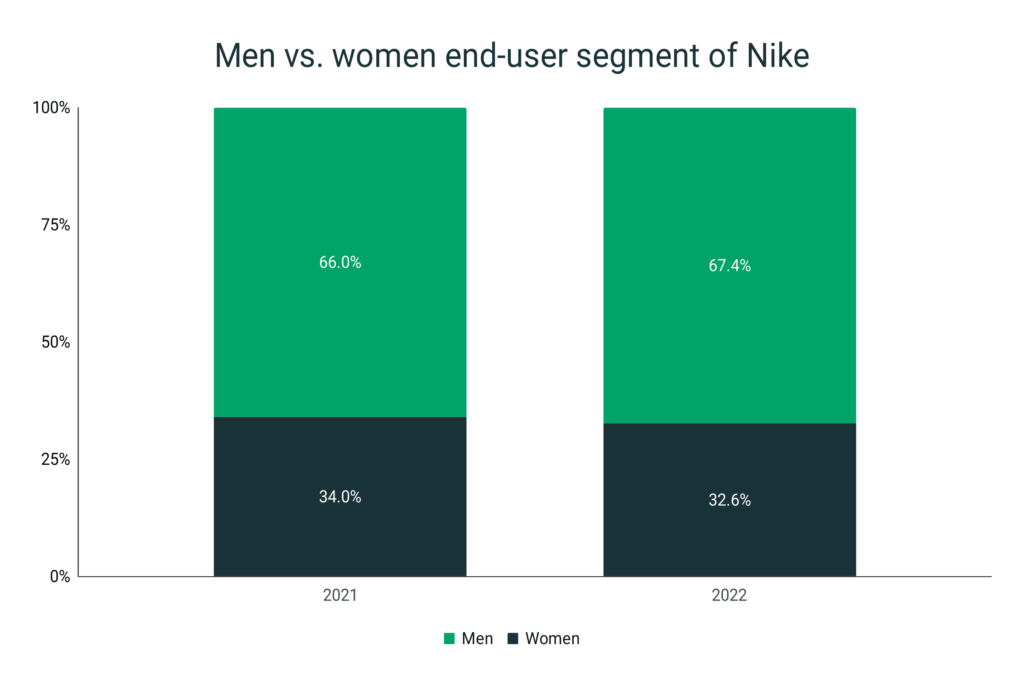
- In 2022, Nike’s customer base is still mostly male, with 67.4% of its shoppers being men.
- This is an increase from 2021, where 66% of Nike’s shoppers were male, showing a 1.4% rise in the male customer segment.
- In contrast, the percentage of female shoppers dropped to 32.6% in 2022, down from 34% in 2021, indicating a 1.4% decrease.
- As of 2023, Nike offers a total of 773 footwear products.
- Of these, 342 products, or 44.2%, are designed exclusively for men.
- Women-only products make up 38.1% of Nike’s footwear lineup.
- Nike also offers 137 unisex shoe models, which are available for all genders.
You May Also Like To Read
- Fujifilm Statistics
- L’Oréal Statistics
- Puma Statistics
- Levi’s Statistics
- Gillette Statistics
- Tommy Hilfiger Statistics
Men vs. women end-user segment of Nike
|
Year |
Women | Men |
| 2021 | 34% |
66% |
|
2022 |
32.6% |
67.4% |
Nike Shoe Sustainability
Percent share of sustainable materials in Nike footwear
|
Year |
Share of recycled materials |
| 2015 |
31% |
|
2016 |
31% |
| 2017 |
32% |
|
2018 |
32% |
| 2019 |
30% |
|
2020 |
29% |
- As of 2022, Nike’s 30-year-old Nike Grind program has reused a total of 30 million pounds of repurposed and recycled materials.
- In 2020, 29% of the materials used in Nike’s footwear were sustainable, which is 1% lower than the 30% reported in 2019.
- In 2017 and 2018, Nike used 32% sustainable materials in its shoe manufacturing process, the highest percentage in six years.
- From 2015 to 2020, Nike averaged 30.8% sustainable materials in its footwear production.
- In 2020, Nike transformed end-of-life footwear into 252 tons of textile fluff, 131 tons of rubber, and 135 tons of foam.
- Additionally, around 70 tons of unsellable and post-consumer shoes were recycled by Nike in 2020.
Nike Employee Statistics
- Nike has employed almost 83,700 employees globally as of May 31, 2023.
- The largest group of Nike website visitors is between 25 and 34 years old, making up 30.82%.
- On a global platform, Nike has over 500,000 employees producing its footwear.
- In addition, outsourcing its production has given Nike more flexibility and responsiveness to market trends and customer demands.
- Following closely, customers aged between 18 and 24 use 25.89% of the website.
- In 2022, Nike. Inc. has a global workforce of almost 79,100 employees, reflecting a growth of nearly 7.91%.
- Nike also emphasizes fair labor practices and ethnic sourcing.
- Outsourcing as a production strategy has resulted in success on a global athletic footwear standard.
- Age groups between 35 and 44, 45 to 64, 55 to 64, and 65+ also show notable interest in Nike’s products, making up almost 19.94%, 12.32%, 6.87%, and 4.16% of visitors, respectively.
- As per Nike Statistics, 44% of the workforce is females, and almost 56% is male.
- Nike also outsources the work to contractors in other countries, such as the Philippines, China, Vietnam, Indonesia, and Taiwan.
- The maximum number of employees identified was 61% White, 16% Hispanic or Latino, and 11% African American.
- The tenure for an employee at Nike is 3.3 years.
- Nike implies quality control measures to guarantee that the products manufactured by the contractors are considered to the company’s standards.
- Nike’s outsourcing decision has benefited it by lowering its inventory levels, minimizing price markdowns, and guaranteeing customer satisfaction.
- Nike’s minimum annual salary is $37,434, and employees tend to support the Democratic party.
- Nike prioritizes employee development and growth through extensive training programs and investment in professional development.
Nike Demographics
- Nike is a rare brand with a vast target audience. It targets consumers aged 18 to 40.
- As per Statista, in 2020, the official Nike sales showed a remarkable income.
- As per Statista, Nike women’s clothing and sportswear generated almost 46.4 billion in revenue in 2021.
- Menswear generates more noteworthy revenue with 14.2 billion Euros.
Nike Geographical Statistics
- 34% of Americans, 11% of residents of the Republic of Korea, and 5% of U.K. residents visit the Nike website.
- Roughly 5.3 million people claim that they have worn Nike clothing in 2023.
- Nearly 61% of the men in the U.K. like Nike products. Nike is the most popular sportswear brand in the United Kingdom. Almost 4 out of 5 men have at least 1 product of Nike.
- Nike Sports accessories are used by almost 1.5 million people in the U.K.
- In 2022, North America generated revenue of $17.2 billion or 39%, whereas revenue from the EMEA area was $11.5 billion and $11.5 billion, respectively. China generated $8.3 billion in revenue, and the LATAM and APAC regions generated 45.3 billion and 45.3 billion, respectively.
- Nike is notable in the global logistics and distribution section, having many distribution centers worldwide.
Nike Advertising Statistics
- In 2020, Nike only spent almost $3.59 billion U.S. dollars on advertising.
- Nike spent almost $150.4 million on social media only in 2021.
- Nike’s T.V. spending was almost $239.6 million in 2022.
- Nike spent almost $49.2 million on advertisements in the U.S. in just March 2022.
- As of 2020, Nike has always been a leading advertiser in the clothing and sports accessories industry in the U.S., and advertising spends almost $691 million.
- 73% of Nike’s advertisements were sports-themed in 2022.
- Nike used the 1988 slogan “Just Do It,” which was known by almost 90% of Americans.
- Nike’s digital advertising spent almost 13% more than last year.
Nike Stores Worldwide
| Year | Number Of Stores |
|---|---|
| 2023 | 1032 |
| 2022 | 1046 |
| 2021 | 1048 |
| 2020 | 1096 |
| 2019 | 1152 |
| 2018 | 1182 |
| 2017 | 1142 |
| 2016 | 1045 |
| 2015 | 931 |
(Source: marketsplash.com)
- In 2023, Nike will operate 1,032 retail stores globally, with stores located in the United States and other countries worldwide.
- In 2015 and 2016, Nike started with 931 and 1045 stores worldwide.
- As we move forward in the years 2017, 2018, and 2019, the global count of the stores was 1142, 1182, and 1152, respectively.
- In 2020 and 2021, Nike’s sales and demand reduced, and there were 1096 and 1048 outlets, respectively.
- The numbers were 1046 and 1032 in 2022 and 2023, respectively, so no special change was observed.
- Europe is another primary market for Nike’s growth.
- 50% of the Nike factory stores, a 3rd are in-line and employee stores and a quarter are Converse stores.
- Nike’s target market is a variety of places all over the globe, generally in urban centers.
- Nike generates more revenue from North America than any other part of the world.
- Nike has seen noteworthy growth in emerging markets like China, Brazil, and India, with significant sales of sports and fitness products.
- According to Nike Statistics, Nike has made an established stride in Asia, especially in China, Japan, and South Korea.
Nike Sponsorships and Endorsements
- Nike has been named the world’s most remarkable sports brand, with a value of $452 million.
- According to Nike Statistics, Turkey has the most Nike stores, with almost 170 official retail shops.
- In 2020, the organization employed nearly 75,400 employees.
- Air Jordan was introduced in accumulating $94.6 million in sales during 1st year.
- Nike spends almost $4.5 billion on sponsorships and athletes per year.
- Per SportsPro, Nike has nearly 8.7 billion in revenue from social media engagement posts promoting the brand.
- As per Statista, Nike has 1,048 stores all around the world.
- As per The Richest, Air Jordan generates almost $73 million annually.
- Nike has 73,300 workers globally.
- As per Statista, Nike has 40 stores in the United Kingdom.
Most Expensive Nike Footwear
- Solid Gold OVO* Air Jordan 10 is worth $2 million to date.
- Kanye West * Nike Air Yeezy 1 ‘Prototype’ is worth $1.8 million respectively.
- Michael Jordon’s Game-Worn Nike Air Ship is worth $1.47 million.
Nike Endorsements Facts
- Nike, a popular footwear and sportswear company, sponsors many sporting events, including the Super Bowl.
- Nike is a sponsor of the prestigious football club FC Barcelona.
- At the time of Fox’s Super Bowl LVII telecast, Nike was the most popular brand, which had almost 1,079 seconds of on-screen time, and the media cost $211.1 million.
- The 57th edition of the Super Bowl took place at the State Farm Stadium in Glendale, Arizona, on February 12, 2023, which marked the cumulation of the National Football League.
- Nike spends almost $4.5 billion on sponsorships and athlete endorsements every year.
- The Dawn Project aired an almost 30-second advertisement that calls for a ban on Tesla’s Full Self Driving system.
- The Tesla advertisement costs $598,000, and it features a video clip.
- According to SportsPro, Nike is the world’s most-marketed sports brand, with a value of $452 million.
- Nike’s athlete endorsements involve a lifetime deal with Cristiano Ronaldo, predicted to exceed $750 million in the coming years.
The Popularity of Nike
- By 2022, 92% of Americans are familiar with the Nike brand.
- More than half of the American population, 56%, use Nike shoes.
- Despite widespread use, only 49% of American consumers are loyal to the Nike brand.
- As of August 2023, 140.4 million people visited Nike’s online website.
- Visitors to the Nike website spent an average of 3 minutes and 44 seconds per visit.
- On average, each visitor to the Nike website views 5.2 pages.
- Among teenagers, especially those in Generation Z, 61% prefer Nike, making it their top choice.
- Converse, another brand owned by Nike, is the second choice for 10% of Gen Z consumers.
- Nike ranks 85th among Fortune 500 companies in America.
- Forbes ranks Nike as the 13th most valuable brand in the world.
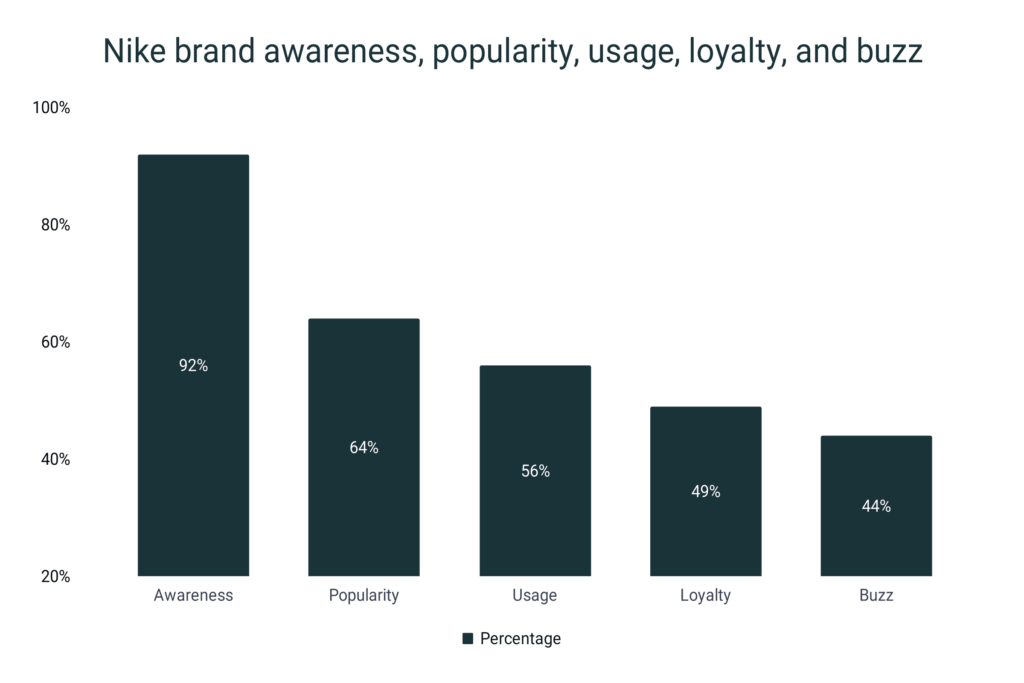
Technology Used by Nike
- Nike Fit: This technology uses augmented reality to measure your feet and recommend the right size for Nike footwear. It aims to enhance the online shopping experience by ensuring a better fit.
- Nike Adapt Technology: Nike Adapt is a self-lacing technology that allows users to adjust the fit of their shoes using a smartphone app. This technology was initially introduced in the Nike HyperAdapt and later in the Adapt BB basketball shoe.
- Nike Flyknit: Flyknit is a technology that utilizes a lightweight, knitted upper material to create a form-fitting and virtually seamless shoe. It provides support and breathability while reducing waste in the manufacturing process.
- Nike React Foam: Nike React is a cushioning technology used in the midsoles of some Nike running and basketball shoes. It is designed to be responsive, durable, and lightweight.
- Nike Dri-FIT: Dri-FIT is a moisture-wicking fabric innovation used in Nike apparel. It helps keep athletes dry and comfortable by pulling sweat away from the body to the fabric’s surface.
- Nike Air: Nike’s Air cushioning technology, introduced in the Air Max series, provides lightweight and responsive cushioning by incorporating pressurized air into the midsole.
- Nike Vaporfly: The Vaporfly series, including the Vaporfly and Alphafly, features innovative designs and materials to improve running performance. These shoes gained attention for their use in elite marathons.
Conclusion
Nike Statistics states that the brand is among the 50 most valued organizations globally and the number 1 sports brand worldwide. Nike’s profits were adversely affected during the pandemic, and its profitability decreased. Nike’s sponsorship continues to prosper, and Nike’s brand loyalty statistics show how consistent it is with all demographic groups.
Nike has several physical retail stores that are witnessing a decline, but Nike likers all over the globe still need to go online. Innovative strategies range from investing in digital advertising to outsourcing products. Nike’s journey is an enthralling statement of the potential of strategic advertising.
Sources

Aruna Madrekar is an editor at Coolest Gadgets, focusing on SEO and content creation. She writes and edits engaging articles, making complex information easy to understand with charts and graphs. Aruna's work on smartphone reviews and app statistics helps Coolest Gadgets reach a wide audience with valuable insights.










